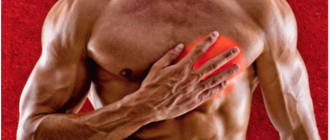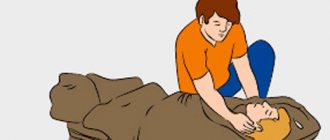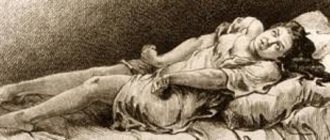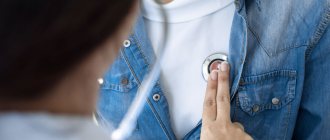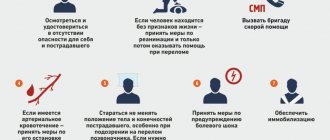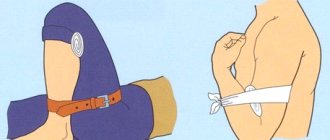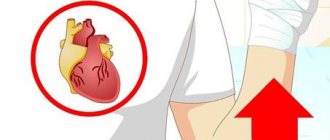Emergency care for hypertensive crisis
Category: Prevention.
Hypertensive crisis is a dangerous complication of arterial hypertension that requires emergency care. Every person suffering from hypertension must remember that this hypertensive crisis can occur at almost any time, and it does not matter whether the patient is in stage I or stage III of the disease. Therefore, not only all hypertensive patients, but also their loved ones should know how to provide first aid in case of a sharp increase in blood pressure.
There are many reasons for the development of a hypertensive crisis. Most often this condition occurs for the following reasons
- self-cessation of antihypertensive drugs or their irregular use, emotional stress
- changes in weather, especially changes in atmospheric pressure
- overwork, alcohol abuse
- overeating, large meals
- excessive physical activity;
- disturbances in the functioning of the blood pressure regulation center in the brain caused by various reasons.
Some patients mistakenly believe that quickly lowering blood pressure to normal levels will help quickly get rid of the symptoms accompanying a hypertensive crisis. Under no circumstances should you sharply reduce blood pressure; this can lead to collapse, accompanied by loss of consciousness. In severe cases, this can lead to the development of ischemic changes in the brain and other organs as a result of depletion of blood flow. It is believed that blood pressure should be reduced gradually, by no more than 20-30 mm. rt. Art. at one o'clock. If signs of a hypertensive crisis appear in a patient for the first time, then it is necessary to immediately consult a doctor or call an ambulance.
The attending cardiologist teaches his patients suffering from arterial hypertension what to do during a hypertensive crisis. Many patients are able to cope with this condition on their own and do not seek medical help. But sometimes a hypertensive crisis can be the first manifestation of hypertension, the existence of which a person might not have known before.
What to do for emergency care during a hypertensive crisis
- First of all, it is necessary to calm the patient. Panic is a bad ally in any emergency, and in this situation, anxiety will contribute to an even greater increase in pressure.
- You can take Corvalol, tincture of valerian or motherwort.
- It is necessary to restore breathing. To do this, you need to take several deep breaths and exhalations.
- You also need to ensure a flow of fresh air into the room where the patient is located by opening a window or vent.
- It is advisable to put the patient to bed, giving him a semi-sitting position with the help of pillows, to warm him up and ensure peace.
- You need to apply an ice pack or a cold compress to your head, and put mustard plasters on your calves or the back of your head, or apply warm heating pads to your feet and legs (for 15-20 minutes).
- It is necessary to take an extraordinary dose of blood pressure medication prescribed by your doctor.
- If chest pain and shortness of breath occur, take 1 tablet of nitroglycerin and call an ambulance.
- While waiting for the doctor to arrive, you can, if necessary, take 2 more tablets at 5-minute intervals. You cannot take more than 3 tablets of nitroglycerin. For people suffering from arterial hypertension, doctors recommend that they always keep on hand antihypertensive drugs such as captopril (Capoten) or (nifedipine Corinfar, Cordaflex). It is better to discuss the use of these drugs during a hypertensive crisis with your doctor at a scheduled appointment. If signs of a hypertensive crisis appear, you can take ½ tablet of captopril (meaning a dosage of 25 mg) or 10 mg of nifedipine sublingually (under the tongue). If the expected effect after taking these drugs in the indicated dosage does not occur after half an hour, then you can take another same dose, but no more!
- If there is no effect, you must call a doctor after another 30 minutes. Blood pressure should be measured at least once every 20 minutes.
- If blood pressure does not decrease during the measures taken, the patient’s condition worsens, chest pain or other alarming symptoms appear, then it is necessary to urgently call an ambulance team. In some cases, a hypertensive crisis is stopped by intravenous or intramuscular administration of drugs by a doctor.
In case of a complicated hypertensive crisis, as well as when this condition occurs for the first time, emergency hospitalization in a hospital is necessary, which should not be refused. To avoid dangerous complications of hypertension, the patient must constantly independently monitor his blood pressure, record its readings in a special diary and not skip taking antihypertensive drugs prescribed by the doctor. After all, just one missed dose of medication can lead to a jump in blood pressure.
Symptoms of hypertensive crisis
- A sharp increase in blood pressure to 220/120 mm Hg. Art. and higher.
- Headache, dizziness, tinnitus, black spots flashing before the eyes.
- Dyspnea.
- Nausea, vomiting.
- Chest pain.
- Neurological disorders (convulsions, impaired consciousness, paralysis).
A hypertensive crisis may be accompanied by a feeling of fear, trembling, chills, redness of the facial skin, swelling of the face, and blurred vision. Particular danger of hypertensive crisis
Represents for patients suffering from any diseases of the brain and heart.
First aid for acute cerebrovascular accident (ACVA)
The main signs (symptoms) of acute cerebrovascular accident:
• numbness, weakness, “disobedience” or paralysis (immobility) of an arm, leg, half of the body, distortion of the face and/or drooling on one side;
• speech disorders (difficulties in choosing the right words, understanding speech and reading, slurred and unclear speech, up to complete loss of speech);
• disturbances or loss of vision, double vision, difficulty focusing;
• imbalance and coordination of movements (feelings of “swaying, sinking, body rotation, dizziness”, unsteady gait up to falling);
• unusual severe headache (often after stress or physical exertion);
• confusion or loss of consciousness, uncontrollable urination or bowel movements.
If any of these signs suddenly appear, call an ambulance immediately, even if these manifestations of the disease were observed for only a few minutes
Before the emergency medical team arrives:
• If the patient is unconscious, lay him on his side, remove removable dentures (food debris, vomit) from the mouth, make sure that the patient is breathing.
• If the victim is conscious, help him to a comfortable sitting or semi-sitting position in a chair or on a bed, placing pillows under his back. Provide fresh air. Unbutton your shirt collar, belt, waistband, and remove tight clothing.
• Measure your blood pressure. If its upper level exceeds 220 mm Hg. Art., give the patient a drug that lowers blood pressure, which he took before.
• Measure your body temperature. If t=38°C or more, give the patient 1 g of paracetamol (2 tablets of 0.5 g, chew, swallow). If paracetamol is not available, do not give other antipyretic drugs!
• Put ice on your forehead and head, you can take food from the freezer, put in waterproof bags and wrapped in a towel.
• If the patient has previously taken drugs that lower blood cholesterol from the statin group (simvastatin, lovastatin, fluvastatin, pravastatin, atorvastatin, rosuvastatin), give the patient the usual daily dose.
• If the victim has difficulty swallowing and saliva is dripping from his mouth, tilt his head towards the weaker side of the body and blot the dripping saliva with clean tissues.
• If the victim is unable to speak or has slurred speech, reassure and reassure him that the condition is temporary. Hold his hand on the non-paralyzed side, stop him from trying to talk, and don't ask questions that require an answer. Remember that although the victim cannot speak, he is aware of what is happening and hears everything that is said around him.
Forms of hypertensive crisis
Cerebral angiohypotonic crisis with clinical manifestations of hypertensive encephalopathy
The most common form of hypertensive crisis. The reason is an excessive increase in cerebral blood flow and relaxation of cerebral vessels. The patient feels a pressing headache, a feeling of fear, dizziness, lethargy. Blood pressure may rise to 170/110 mmHg. This type of hypertensive crisis
often accompanied by vomiting.
Cerebral ischemic crisis
Less common form, but most dangerous. Blood pressure reaches higher numbers - 220/120 mmHg. The patient experiences general symptoms of cerebrovascular disease - dizziness, headache, neurological disorders - numbness of the face or limbs, impaired coordination of movements, short-term blindness or muteness. Cerebral ischemic crisis is a prerequisite for the development of cerebral stroke.
Hypertensive cardiac crisis
A hypertensive cardiac crisis by high blood pressure numbers. The patient experiences shortness of breath, chest pain, rapid heartbeat, and complains of a dry cough. Hypertensive cardiac crisis can cause myocardial infarction.
First aid for a heart attack
Characteristic signs (symptoms) of a heart attack (myocardial infarction):
• sudden (paroxysmal) pressing, squeezing, burning, aching pain in the chest (behind the sternum), lasting more than 5 minutes;
• similar pains are often observed in the left shoulder (forearm), left shoulder blade, left half of the neck and lower jaw, both shoulders, both arms, the lower part of the sternum along with the upper abdomen;
• lack of air, shortness of breath, severe weakness, cold sweat, nausea often occur together, sometimes following or preceding discomfort/pain in the chest;
• it is not uncommon for these manifestations of the disease to develop against the background of physical or psycho-emotional stress, but more often with some interval after them.
Uncharacteristic signs that are often confused with a heart attack:
• stabbing, cutting, pulsating, drilling, constant aching pain for many hours and not changing its intensity in the heart area or in a specific clearly defined area of the chest.
Algorithm for emergency actions in case of a heart attack (advice to the patient)
If you or someone else suddenly has the above characteristic signs of a heart attack, even with weak or moderate intensity, which last more than 5 minutes, do not hesitate, immediately call an ambulance team. Do not wait more than 10 minutes - in such a situation it is life-threatening.
Remember that being intoxicated in this deadly situation is not a reasonable excuse for delaying calling an ambulance!
If you have symptoms of a heart attack and there is no way to call an ambulance, then ask someone to take you to the hospital - this is the only right decision. Never drive yourself unless you have no other choice.
In the most optimal scenario, if a heart attack occurs, you must follow the instructions received from your attending physician; if there are no such instructions, then you must act according to the following algorithm:
• Immediately after an attack occurs, sit down (preferably in a chair with armrests) or lie in bed with the head of the bed raised, take 0.25 g of acetylsalicylic acid (aspirin) (chew the tablet, swallow) and 0.5 mg of nitroglycerin (spray one inhalation dose into the cavity mouth while holding your breath, place one tablet/capsule under the tongue, first bite the capsule, do not swallow); free your neck and provide fresh air (open the vents or windows).
• If pain persists 5-7 minutes after taking acetylsalicylic acid (aspirin) and nitroglycerin, it is imperative (life-saving) to call an ambulance and take nitroglycerin a second time.
• If pain persists 10 minutes after taking the second dose of nitroglycerin, it is necessary to take nitroglycerin a third time.
• If after the first or subsequent doses of nitroglycerin there is severe weakness, sweating, shortness of breath, you need to lie down, raise your legs (on a bolster, etc.), drink 1 glass of water and then, as with a severe headache, do not take nitroglycerin.
• If the patient has previously taken drugs that lower blood cholesterol from the statin group (simvastatin, lovastatin, fluvastatin, pravastatin, atorvastatin, rosuvastatin), give the patient his usual daily dose and take the drug with you to the hospital.
Attention!
A patient with a heart attack is strictly forbidden to get up, walk, smoke or eat until the doctor’s special permission;
You should not take aspirin
(acetylsalicylic acid) if you are intolerant to it (allergic reactions), as well as if there is a clear exacerbation of gastric and duodenal ulcers;
Nitroglycerin should not be taken
if there is severe weakness, sweating, or if there is severe headache, dizziness, or acute impairment of vision, speech, or coordination of movements.
How much time do you have?
If a patient develops a complicated second-degree hypertensive crisis and all its symptoms are observed, first aid involves urgently calling doctors. It is very important to stop an attack in the first 24 hours from the moment the main symptoms appear.
Health care workers stop a hypertensive crisis, guided by medical protocol. It describes the standard of care for each specific disease. Even the ambulance paramedics' bags are stowed according to protocol. Therefore, it is very important when calling an ambulance to say that the patient is experiencing symptoms of a hypertensive crisis.
The actions of ambulance workers are aimed at quickly reducing high blood pressure by slowly administering drugs that relieve the hypertensive effect.
This or that medicine is used depending on the general condition of the patient and blood pressure indicators. When choosing a drug, the age of the patient, his weight, the clinical picture of the disease, what treatment the patient took, and the general condition of the body are of great importance.
Emergency medical workers use the following drugs in their practice:
- "Dibazol";
- "Furosemide";
- "Clonidine";
- "Droperidol."
These drugs are administered in a clear sequence and dosage that is needed for the patient’s specific condition. If the ambulance is called too late and the patient experiences complications, he will be immediately hospitalized in the hospital, where he will be given appropriate treatment.
What to do indoors?
First aid for a hypertensive crisis indoors involves performing a certain algorithm of actions.
- Call an ambulance.
- Help the patient take a semi-sitting position and support him with pillows.
- Unfasten the buttons on clothing so that the victim can breathe freely.
- Open the windows to allow fresh air into the room.
- Place an ice pack on your forehead and a warm heating pad on your feet.
- Give the victim his usual medicine to lower blood pressure (if available).
- Allow the Captopril tablet to dissolve. For severe headaches, the patient can take one Furosemide tablet.
This emergency care algorithm refers to pre-medical methods for a hypertensive crisis and does not replace a full medical examination. The main rule of such assistance is not to harm the patient. Therefore, all medications taken by the victim must have a clear dosage.
For example, an overdose of Captopril can lead to angioedema, the consequences of which will be disastrous for the body. It would seem, how can “Nitroglycerin” harm? An increased dose of the drug can provoke a rapid drop in pressure and serious complications of the circulatory system. In the case of a complicated crisis, the patient requires more serious medical care.
What to do outside?
A hypertensive crisis can happen at any time, so everyone should know how to provide first aid. This condition often occurs due to changes in weather conditions. Frosts have a great impact on the body of hypertensive patients, which constrict blood vessels, resulting in increased blood pressure.
If a person has a seizure on the street and you witness it, do not panic. The first thing to do is call an ambulance. While you are waiting for the doctors to arrive, the patient must be seated on a bench or the ground. If he has difficulty breathing, unbutton his clothes and give him something to drink. If a person has medications with him that he usually takes to stabilize his blood pressure, he should be given them to drink.
This is an emergency situation, but there is no need to panic and be afraid to provide help, because this can happen to any of us.
First aid for sudden death (tips for eyewitnesses)
Most often, sudden death occurs due to cessation of cardiac activity.
The main signs (symptoms) of sudden death:
• Sudden loss of consciousness, often accompanied by agonal movements (a standing or sitting person falls, convulsive muscle tension, involuntary urination and defecation are often observed; a lying person sometimes makes a convulsive attempt to sit up or turn on his side).
• Sudden complete cessation of breathing, often after a short period (5-10 seconds) of agonal pseudobreathing: the patient makes wheezing and/or gurgling sounds, sometimes similar to a convulsive attempt to say something.
Complications of hypertensive crisis
A hypertensive crisis is dangerous not so much in itself as the influence of high blood pressure on target organs - in the first place. Disruption of blood microcirculation in the brain leads to swelling (hypertensive encephalopathy).
During an increase in blood pressure, the walls of the blood vessels in the brain experience enormous stress, which can lead to hemorrhage in the brain (hemorrhagic stroke).
A sharp increase in blood pressure also affects the function of the heart, not excluding the possibility of angina pectoris - an acute lack of blood supply to the heart muscle with the development of acute heart failure, expressed in the form of shortness of breath, suffocation, and pulmonary edema. The most severe complications of hypertensive crisis
are heart attack and stroke.

